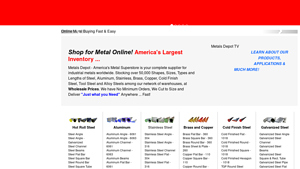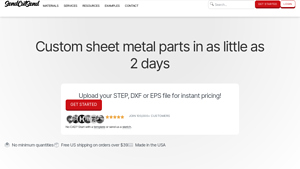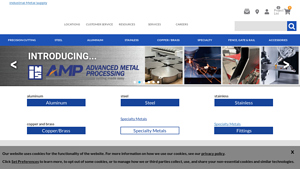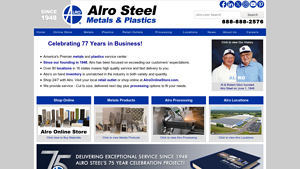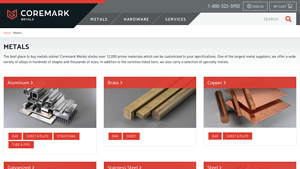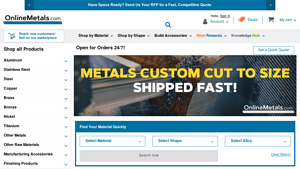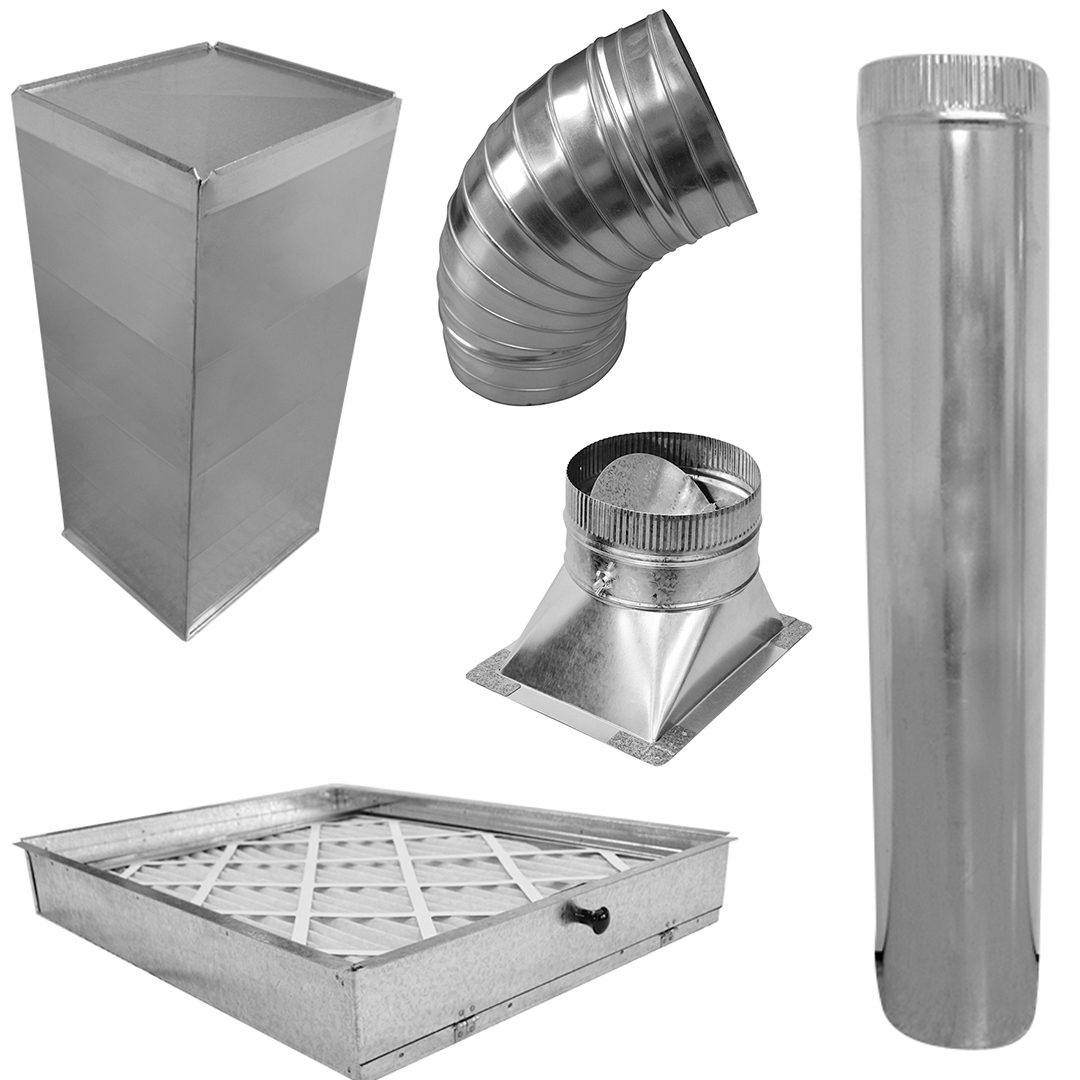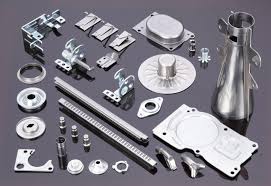Top 7 Metal Parts Supplier List and Guide
Top 7 Metal Parts Supplier Manufacturers & Suppliers List
1. Metals Depot – Industrial Metals
Domain: metalsdepot.com
Registered: 1999 (26 years)
Introduction: Metals Depot offers a wide range of industrial metals including Steel, Aluminum, Stainless Steel, Brass, Copper, Cold Finish Steel, Tool Steel, and Alloy Steels. They stock over 50,000 shapes, sizes, types, and lengths with no minimum orders. Key product categories include:
– Steel: Hot Roll Steel, Steel Angle (Galvanized), Steel Channel, Steel Beams, Steel Flat Bar, Steel Square Bar, Steel Roun…
2. SendCutSend – Custom Sheet Metal Fabrication
Domain: sendcutsend.com
Registered: 2015 (10 years)
Introduction: SendCutSend offers custom sheet metal fabrication services including laser cutting, CNC routing, waterjet cutting, anodizing, bending & forming, countersinking, dimple forming, hardware insertion, plating, powder coating, tapping, tumbling, and deburring. They provide instant pricing for custom parts with no minimum quantities and free US shipping on orders over $39. Key materials include cold rol…
3. Industrial Metal Supply Co. – Metal Products
Domain: industrialmetalsupply.com
Registered: 1999 (26 years)
Introduction: Industrial Metal Supply Co. offers a wide range of metal products including:
– Steel: Hot Rolled, Cold Rolled, Galvanized, 4130, Sheets & Plates, Tubing, Structural Shapes (Angles, Beams, Channels, etc.), and various forms (Bars, Squares, Rectangles, etc.).
– Aluminum: 6061, 5052, 3003 in various forms including Sheets, Plates, Bars, and Tubing.
– Stainless Steel: 304, 316 in Sheets, Plates, Ba…
4. Alro – Metals and Plastics Products
Domain: alro.com
Registered: 1996 (29 years)
Introduction: Alro offers a wide range of metals and plastics products, including:
Metals Products:
– Alloy Aluminum
– Aluminum Plate
– Brass
– Bronze
– Copper
– Cast Iron
– Stainless Steel
– Tool Steel
– Expanded Metal
– Grating
– Carbon Steel (Bars, Plate, Sheet, CF Bars, Structurals, Tubing, Pipe, Rebar, Threaded Rod)
– Chrome Plated Bar
Plastics Products:
– ABS
– Acetals
– Acrylic
– Cast…
5. Dalsin Industries – Metal Fabrication Services
Domain: dalsinind.com
Registered: 1998 (27 years)
Introduction: Dalsin Industries specializes in American-made metal parts and products, offering a range of metal fabrication services including sheet metal fabrication, laser cutting, welding (MIG, TIG, robotic), automated punching, and bending. They work with various materials such as aluminum, carbon steel, stainless steel, coated steel, copper, bronze, and brass. Their product offerings include metal enclosu…
6. Coremark Metals – Aluminum
Domain: coremarkmetals.com
Registered: 2018 (7 years)
Introduction: Coremark Metals offers a wide variety of metals including Aluminum, Brass, Copper, Galvanized, and Stainless Steel in various shapes such as Bar, Sheet & Plate, and Structural Tube & Pipe. They stock over 12,000 prime materials that can be customized to specifications. Key products include: Aluminum Bar, Sheet & Plate; Brass Bar, Sheet; Copper Bar, Sheet & Plate; Galvanized Bar, Sheet, Structural …
7. OnlineMetals – Raw Materials & Metals
Domain: onlinemetals.com
Registered: 1997 (28 years)
Introduction: OnlineMetals.com offers a wide range of raw materials including metals, plastics, and other materials. Key product categories include:
– Metals: Alloy Steel, Aluminum, Beryllium, Copper, Brass, Bronze, Carbon Steel, Cast Iron, Lead, Magnesium, Nickel, Nickel Silver, Pewter, Stainless Steel, Titanium, Tool Steel, Tungsten Carbide, Zinc.
– Plastics and Other Materials: Rubber, Carbon Fiber, Fibergl…
Introduction: Navigating the Global Market for metal parts supplier
In today’s competitive landscape, sourcing reliable metal parts suppliers presents a significant challenge for international B2B buyers. Whether you’re in Brazil, Saudi Arabia, or across Europe, the complexities of navigating the global market can lead to costly missteps. This comprehensive guide is designed to simplify the process, providing insights into various types of metal parts, their applications, and the best practices for supplier vetting.
From understanding the nuances of material selection to exploring the costs associated with different manufacturing methods, this resource empowers you to make informed purchasing decisions. By delving into key factors such as quality standards, delivery times, and post-processing services, you’ll be equipped to evaluate potential suppliers effectively.
Moreover, we will address the specific needs of buyers in emerging markets, highlighting strategies to overcome barriers to entry and establish successful partnerships. As you navigate the intricacies of the metal parts supply chain, this guide serves as your roadmap, ensuring you find the right suppliers who align with your business goals and quality expectations. Prepare to transform your sourcing strategy and enhance your operational efficiency with actionable insights tailored to your unique market challenges.
Understanding metal parts supplier Types and Variations
| Type Name | Key Distinguishing Features | Primary B2B Applications | Brief Pros & Cons for Buyers |
|---|---|---|---|
| Custom Metal Fabricators | Offer tailored solutions; rapid prototyping; low MOQ | Aerospace, automotive, machinery | Pros: Flexibility, quick turnaround. Cons: Higher costs for small runs. |
| Stock Metal Suppliers | Large inventory of standard sizes and materials | Construction, manufacturing | Pros: Cost-effective, immediate availability. Cons: Limited customization. |
| Specialty Metal Distributors | Focus on niche materials (e.g., titanium, composites) | Medical, defense, high-performance | Pros: Unique materials, expert knowledge. Cons: Longer lead times, higher prices. |
| Online Metal Services | Digital platforms for instant quoting and ordering | Small businesses, startups | Pros: User-friendly, fast service. Cons: May lack personal touch. |
| Integrated Supply Chain Partners | Comprehensive services including logistics and processing | Large-scale manufacturing, OEMs | Pros: Streamlined operations, cost savings. Cons: Potential complexity in communication. |
What Are the Characteristics of Custom Metal Fabricators?
Custom metal fabricators specialize in producing bespoke components tailored to specific client designs. These suppliers often utilize advanced technologies such as laser cutting and CNC machining to deliver high precision and rapid prototyping capabilities. They are suitable for industries requiring unique parts, such as aerospace and automotive, where standard components may not suffice. When purchasing, buyers should consider lead times, as custom orders can take longer than stock items, and ensure that the supplier can meet their specific design requirements.
How Do Stock Metal Suppliers Operate?
Stock metal suppliers maintain extensive inventories of standard metal shapes and sizes, allowing for immediate fulfillment of orders. They cater primarily to industries like construction and manufacturing that need readily available materials for large-scale projects. Buyers benefit from lower costs and quick access to materials, though they may face limitations in customization options. It’s crucial for buyers to evaluate the supplier’s inventory breadth and stock levels to ensure they can meet project timelines without delays.
What Makes Specialty Metal Distributors Unique?
Specialty metal distributors focus on niche markets, providing rare materials such as titanium, high-performance alloys, or composites. These suppliers are essential in sectors like medical and defense, where specific material properties are critical for performance and safety. While buyers can access unique materials and expert advice, they should be aware of potentially higher costs and longer lead times associated with these specialized products. Evaluating the distributor’s expertise and material certifications is vital for ensuring quality and compliance.
How Do Online Metal Services Enhance Purchasing Efficiency?
Online metal services offer a digital platform for buyers to obtain instant quotes and place orders for metal parts. These services are particularly advantageous for small businesses and startups that require quick turnaround times without the need for extensive negotiation. While they provide ease of use and speed, buyers may miss out on personalized service and support. It is essential for B2B buyers to assess whether the online platform meets their specific needs and to consider the potential trade-offs of a less hands-on approach.
What Are the Advantages of Integrated Supply Chain Partners?
Integrated supply chain partners provide a comprehensive approach to metal supply, encompassing not only the provision of raw materials but also logistics, processing, and inventory management. This model is particularly beneficial for large-scale manufacturing operations and OEMs that seek to streamline their procurement processes and reduce costs. However, buyers should be cautious about the complexities that can arise from extensive communication across various services. Establishing clear communication channels and understanding the partner’s capabilities are critical for successful collaboration.
Key Industrial Applications of metal parts supplier
| Industry/Sector | Specific Application of Metal Parts Supplier | Value/Benefit for the Business | Key Sourcing Considerations for this Application |
|---|---|---|---|
| Automotive Manufacturing | Custom metal components for vehicle assembly | Enhances production efficiency and reduces lead times | Material certification, compliance with safety standards |
| Aerospace | Precision machined parts for aircraft systems | Ensures reliability and safety in critical applications | Aerospace-grade materials, strict quality controls |
| Construction | Structural steel components for buildings | Provides durability and structural integrity | Sourcing from certified suppliers, adherence to local codes |
| Electronics | Metal enclosures and heat sinks for devices | Protects components and improves thermal management | Customization capabilities, rapid prototyping options |
| Oil & Gas | Specialized fittings and components for pipelines | Enhances operational safety and efficiency | Corrosion-resistant materials, compliance with industry standards |
How are Metal Parts Suppliers Used in Automotive Manufacturing?
In the automotive sector, metal parts suppliers play a crucial role by providing custom components that are essential for vehicle assembly. These suppliers enable manufacturers to streamline production processes, thereby reducing lead times and costs. International buyers, particularly from regions like South America and Africa, must consider material certifications and compliance with safety standards to ensure that the components meet the necessary regulations in their local markets.
What is the Importance of Precision Machined Parts in Aerospace?
The aerospace industry relies heavily on precision machined parts supplied by metal parts suppliers. These components are critical for ensuring the reliability and safety of aircraft systems. Suppliers must provide aerospace-grade materials and adhere to stringent quality controls, as even the slightest defect can have catastrophic consequences. International buyers need to verify the supplier’s certifications and experience in aerospace applications, especially when sourcing from regions like the Middle East and Europe.
How Do Metal Parts Suppliers Support the Construction Industry?
In construction, metal parts suppliers provide structural steel components that are vital for building integrity and durability. These suppliers help contractors source high-quality materials that comply with local building codes and regulations. For international buyers, particularly in developing regions, sourcing from certified suppliers ensures that projects meet safety standards and can withstand environmental challenges.
Why Are Metal Enclosures Crucial in Electronics?
Metal parts suppliers are essential in the electronics industry by supplying metal enclosures and heat sinks that protect sensitive components. These enclosures not only enhance the aesthetic appeal of devices but also improve thermal management, prolonging the lifespan of electronic products. Buyers from diverse regions, including Brazil and Saudi Arabia, should prioritize suppliers that offer customization capabilities and rapid prototyping options to meet their unique design requirements.
What Role Do Metal Parts Suppliers Play in Oil & Gas?
In the oil and gas sector, specialized fittings and components from metal parts suppliers enhance operational safety and efficiency. These suppliers provide corrosion-resistant materials that are crucial for equipment exposed to harsh environments. International buyers must ensure that their suppliers comply with industry standards and possess the expertise to deliver components that can withstand extreme conditions, thereby mitigating risks in their operations.
3 Common User Pain Points for ‘metal parts supplier’ & Their Solutions
Scenario 1: Inconsistent Quality and Specifications
The Problem: A B2B buyer sourcing metal parts often faces the challenge of inconsistent quality and specifications. This scenario is particularly prevalent when dealing with multiple suppliers or when parts are manufactured in different locations. A buyer may receive components that do not meet the required tolerances, which can lead to production delays, increased costs, and a damaged reputation with clients. This inconsistency can stem from variations in manufacturing processes, raw material quality, or even lack of clear communication regarding specifications.
The Solution: To mitigate this risk, it is crucial for buyers to establish a clear set of specifications that include tolerances, material grades, and quality standards before engaging with suppliers. It’s advisable to conduct thorough supplier evaluations, including checking their certifications and past performance records. For ongoing projects, implementing a quality assurance process such as regular audits or third-party inspections can help ensure that the metal parts supplied consistently meet the required standards. Additionally, using a centralized platform for documentation can streamline communication and minimize errors related to specifications.
Scenario 2: Long Lead Times Affecting Production Schedules
The Problem: Long lead times can severely disrupt production schedules, especially for B2B buyers who rely on timely deliveries of metal parts to maintain operational efficiency. This issue is often exacerbated when suppliers are unable to provide accurate timelines or when unexpected delays occur due to logistics or production challenges. Such disruptions can lead to project delays, increased costs, and strained relationships with clients who expect timely deliveries.
The Solution: To address lead time issues, buyers should prioritize suppliers that offer transparent and reliable timelines. Engaging with suppliers that provide real-time tracking and updates on orders can significantly enhance visibility throughout the supply chain. Buyers should also consider maintaining strategic relationships with multiple suppliers to create a buffer against delays. Implementing just-in-time (JIT) inventory practices can also help manage lead times effectively. By ordering in smaller batches as needed, buyers can reduce the risk of overstocking while ensuring that they receive the parts they need when they need them.
Scenario 3: Limited Material Options and Customization Capabilities
The Problem: Many B2B buyers encounter limitations when it comes to the variety of materials and customization options offered by metal parts suppliers. This challenge is particularly pronounced for businesses that require specific alloys or unique designs tailored to their projects. Suppliers that lack a diverse inventory or the ability to accommodate custom orders can force buyers to compromise on their product specifications, potentially impacting performance and satisfaction.
The Solution: To overcome these limitations, buyers should seek out suppliers that specialize in a wide range of materials and offer robust customization capabilities. It’s beneficial to engage with suppliers who utilize advanced technologies such as CNC machining or laser cutting, which enable precise customization of parts. Additionally, establishing a collaborative relationship with the supplier can facilitate the development of tailored solutions that meet specific project needs. Buyers should also consider suppliers that provide design assistance or prototyping services, allowing for adjustments and iterations before final production. This proactive approach ensures that the materials and designs align perfectly with project requirements, enhancing overall satisfaction and performance.
Strategic Material Selection Guide for metal parts supplier
What Are the Key Properties of Common Metals Used in Parts Manufacturing?
When selecting materials for metal parts, B2B buyers must consider various properties that directly influence product performance. Here, we analyze four common metals used in manufacturing: Carbon Steel, Stainless Steel, Aluminum, and Copper. Each material has unique characteristics that cater to different applications, making it essential for buyers to understand their pros and cons.
How Does Carbon Steel Perform in Metal Parts Manufacturing?
Carbon Steel is widely recognized for its strength and durability. It exhibits excellent mechanical properties, making it suitable for high-stress applications. Its temperature and pressure ratings are high, which is beneficial for components exposed to extreme conditions. However, it is prone to corrosion, necessitating protective coatings or finishes.
Pros: Carbon Steel is cost-effective and easy to machine, making it a popular choice for a variety of applications. Its high tensile strength allows for the production of robust parts.
Cons: The main limitation is its susceptibility to rust and corrosion, which can reduce its lifespan in humid or corrosive environments.
Impact on Application: Carbon Steel is commonly used in structural components, automotive parts, and machinery. It is vital for buyers to consider the environmental conditions where the parts will be used, especially in regions with high humidity.
Considerations for International Buyers: Compliance with standards such as ASTM A36 is crucial. Buyers from regions like Africa and South America should ensure that their suppliers can meet local regulations regarding material quality and safety.
What Are the Advantages of Using Stainless Steel?
Stainless Steel is renowned for its corrosion resistance, making it ideal for applications exposed to moisture or corrosive substances. It maintains its strength at elevated temperatures and is easy to clean, which is essential in industries like food processing and pharmaceuticals.
Pros: The primary advantage of Stainless Steel is its durability and resistance to corrosion, which extends the life of the product. It also has a polished finish that enhances aesthetic appeal.
Cons: The higher cost compared to other metals can be a deterrent for some buyers. Additionally, its machining can be more complex, requiring specialized tools.
Impact on Application: Stainless Steel is often used in medical devices, kitchen equipment, and marine applications. Its compatibility with various media makes it suitable for diverse environments.
Considerations for International Buyers: Buyers should look for compliance with standards like ASTM A240 for stainless steel products. In regions like the Middle East, where corrosion is a significant concern, ensuring the right grade of stainless steel is critical.
Why Choose Aluminum for Metal Parts?
Aluminum is favored for its lightweight and excellent corrosion resistance. It has a good strength-to-weight ratio, making it suitable for applications where weight reduction is essential, such as in aerospace and automotive industries.
Pros: The lightweight nature of Aluminum reduces transportation costs and improves fuel efficiency in vehicles. It is also highly malleable, allowing for complex shapes.
Cons: Aluminum is generally softer than steel, which can limit its use in high-stress applications. It can also be more expensive than carbon steel.
Impact on Application: Aluminum is ideal for components requiring lightweight and corrosion-resistant properties, such as aircraft parts and packaging materials.
Considerations for International Buyers: Buyers should ensure compliance with standards like ASTM B221. In Europe, the EN standards for aluminum alloys are essential for ensuring quality and compatibility.
What Makes Copper a Unique Choice for Metal Parts?
Copper is known for its excellent electrical conductivity and thermal properties. It is often used in electrical applications and plumbing systems due to its ability to resist corrosion and its antimicrobial properties.
Pros: The primary advantage of Copper is its superior conductivity, making it ideal for electrical components. It also has natural antimicrobial properties, making it suitable for sanitary applications.
Cons: Copper is relatively expensive and can be prone to tarnishing over time. Its softness may limit its use in structural applications.
Impact on Application: Copper is commonly used in electrical wiring, plumbing, and heat exchangers. Its compatibility with various media, particularly in plumbing, is a significant advantage.
Considerations for International Buyers: Compliance with standards such as ASTM B170 is essential for ensuring quality. Buyers in regions with stringent electrical safety regulations, such as Europe, should prioritize suppliers who adhere to these standards.
Summary Table of Material Selection for Metal Parts
| Material | Typical Use Case for metal parts supplier | Key Advantage | Key Disadvantage/Limitation | Relative Cost (Low/Med/High) |
|---|---|---|---|---|
| Carbon Steel | Structural components, automotive parts | High tensile strength | Prone to corrosion | Low |
| Stainless Steel | Medical devices, kitchen equipment | Excellent corrosion resistance | Higher cost and complex machining | High |
| Aluminum | Aerospace parts, packaging materials | Lightweight and corrosion-resistant | Softer than steel | Medium |
| Copper | Electrical wiring, plumbing | Superior conductivity | Expensive and prone to tarnishing | High |
This guide provides a comprehensive overview of material selection for metal parts, enabling international B2B buyers to make informed decisions based on their specific needs and regional considerations.
In-depth Look: Manufacturing Processes and Quality Assurance for metal parts supplier
What Are the Key Stages in the Manufacturing Process of Metal Parts?
Manufacturing metal parts involves several critical stages that ensure the final product meets the required specifications and standards. Understanding these stages can help B2B buyers make informed decisions when selecting a supplier.
1. Material Preparation: How Is Raw Material Processed for Metal Parts?
The manufacturing process begins with material preparation, which involves selecting the appropriate raw materials. Common materials include various grades of steel, aluminum, copper, and composites. Suppliers often utilize advanced material handling techniques to ensure that the materials are free from defects.
The preparation stage may also involve cutting raw materials into manageable sizes using techniques such as shearing, sawing, or waterjet cutting. This stage is crucial, as the quality of the raw materials directly impacts the final product’s integrity.
2. Forming: What Techniques Are Used to Shape Metal Parts?
Once the materials are prepared, the next stage is forming. This stage can involve various techniques, including:
- Laser Cutting: This precision method utilizes focused light to cut intricate shapes and designs into metal sheets.
- CNC Machining: Computer Numerical Control (CNC) machining allows for high-precision shaping of metal parts using lathes and mills.
- Bending and Stamping: These techniques are employed to create specific angles and shapes in metal sheets and components.
- Casting: For complex geometries, casting processes like sand casting or die casting may be used.
Each of these methods has its own advantages and is selected based on the part’s design, complexity, and material.
3. Assembly: How Are Components Joined Together?
After forming, the assembly stage comes into play, where individual components are joined to create the final product. Common assembly techniques include welding, riveting, and adhesive bonding.
B2B buyers should pay attention to the supplier’s capabilities in this area, as the assembly process can significantly affect the part’s durability and functionality. Automated assembly lines can enhance efficiency and consistency, while manual assembly may allow for more intricate craftsmanship.
4. Finishing: What Processes Enhance the Final Product’s Quality?
Finishing processes are essential for improving the aesthetic and functional properties of metal parts. These processes may include:
- Surface Treatment: Techniques such as anodizing, plating, and powder coating are used to enhance corrosion resistance and surface durability.
- Deburring: This process removes sharp edges and imperfections, ensuring safety and better functionality.
- Quality Inspection: Before final packaging, parts often undergo rigorous inspection to ensure they meet specified tolerances.
B2B buyers should inquire about the finishing options available and their implications for the product’s lifespan and performance.
What Quality Assurance Measures Should B2B Buyers Consider?
Quality assurance is a critical aspect of the manufacturing process that ensures products meet industry standards and customer expectations. For international B2B buyers, understanding the quality assurance measures in place at a supplier can significantly influence purchasing decisions.
1. What International Standards Should Be Considered?
International standards, such as ISO 9001, are essential for establishing quality management systems. Suppliers adhering to these standards demonstrate a commitment to consistent quality and continuous improvement.
Other industry-specific certifications, such as CE marking for products sold in Europe or API certification for oil and gas components, should also be considered. These certifications indicate compliance with regulatory requirements and industry best practices.
2. What Are the Key Quality Control Checkpoints in Manufacturing?
Quality control (QC) checkpoints are integral to the manufacturing process, ensuring that defects are identified and addressed promptly. Common QC checkpoints include:
- Incoming Quality Control (IQC): This involves inspecting raw materials upon arrival to ensure they meet specifications.
- In-Process Quality Control (IPQC): Continuous monitoring during the manufacturing process helps identify issues early.
- Final Quality Control (FQC): A comprehensive inspection of finished products ensures they meet all design and quality specifications before shipment.
B2B buyers should inquire about the supplier’s QC processes and how they handle deviations from quality standards.
3. How Can B2B Buyers Verify a Supplier’s Quality Control?
Verifying a supplier’s quality control measures is essential for B2B buyers, especially when sourcing internationally. Here are several effective methods:
- Supplier Audits: Conducting on-site audits allows buyers to assess the supplier’s manufacturing processes, quality management systems, and adherence to standards.
- Quality Reports: Requesting detailed quality reports can provide insights into the supplier’s QC performance, including defect rates and corrective actions taken.
- Third-Party Inspections: Engaging third-party inspection agencies can offer an unbiased assessment of the supplier’s quality practices and products.
4. What Nuances Should International B2B Buyers Be Aware Of?
International B2B buyers, particularly from regions like Africa, South America, the Middle East, and Europe, should be aware of several nuances in quality assurance. Different regions may have varying standards and expectations regarding quality.
Understanding local regulatory requirements, cultural attitudes toward quality, and common practices can enhance communication and expectations between buyers and suppliers. Additionally, language barriers may affect the clarity of quality specifications, making it essential for buyers to ensure that both parties have a mutual understanding of quality requirements.
Conclusion: How to Choose a Metal Parts Supplier with Strong Manufacturing and Quality Assurance?
When selecting a metal parts supplier, B2B buyers should thoroughly evaluate the supplier’s manufacturing processes and quality assurance measures. By understanding the stages involved in manufacturing, the relevant quality standards, and verification methods, buyers can make informed decisions that align with their quality expectations and business needs. This diligence not only ensures the procurement of high-quality parts but also fosters long-term partnerships built on trust and reliability.
Practical Sourcing Guide: A Step-by-Step Checklist for ‘metal parts supplier’
Introduction
In the global marketplace, sourcing metal parts effectively is crucial for manufacturers and businesses looking to optimize their production processes. This guide provides a step-by-step checklist to help B2B buyers navigate the complexities of procuring metal parts from suppliers, ensuring quality, reliability, and cost-effectiveness.
Step 1: Define Your Technical Specifications
Before reaching out to suppliers, clearly outline your technical requirements. This includes dimensions, tolerances, material types, and surface finishes. Precise specifications will help suppliers provide accurate quotes and reduce the risk of errors during production.
- Key Considerations:
- Identify the specific metal types needed (e.g., stainless steel, aluminum).
- Determine any certifications required for the parts, such as ISO standards.
Step 2: Research Potential Suppliers
Conduct thorough research to identify potential metal parts suppliers that align with your needs. Look for suppliers with a proven track record in your industry, as well as positive customer reviews and ratings.
- Helpful Resources:
- Industry directories and trade shows can provide valuable insights into reputable suppliers.
- Online reviews and testimonials from other B2B buyers can highlight supplier reliability.
Step 3: Evaluate Supplier Capabilities
Once you’ve identified potential suppliers, assess their production capabilities. This includes understanding their manufacturing processes, quality control measures, and capacity to meet your order volumes.
- Questions to Ask:
- What types of cutting and finishing techniques do they offer?
- Can they handle custom designs or modifications?
Step 4: Verify Supplier Certifications
Certification verification is essential to ensure that your supplier adheres to industry standards. Look for certifications such as ISO 9001 for quality management and specific material certifications relevant to your order.
- Why It Matters:
- Certified suppliers are more likely to deliver consistent quality and comply with regulatory requirements.
- Certification can also enhance your credibility when presenting your final product to clients.
Step 5: Request Quotes and Compare Pricing
Request detailed quotes from multiple suppliers based on your specifications. Ensure that the quotes include all potential costs, such as shipping, taxes, and any additional processing fees.
- Comparison Tips:
- Look beyond just the price; consider lead times, payment terms, and after-sales support.
- Evaluate the total cost of ownership, which includes delivery time and quality assurance.
Step 6: Conduct a Sample Order
Before committing to a large order, consider placing a smaller sample order. This allows you to evaluate the supplier’s quality, delivery time, and communication.
- What to Assess:
- Check if the sample meets your specifications and quality standards.
- Evaluate the supplier’s responsiveness and willingness to address any issues that arise.
Step 7: Establish a Long-Term Relationship
Once you’ve identified a reliable supplier, work towards establishing a long-term partnership. Strong supplier relationships can lead to better pricing, priority service, and collaborative problem-solving.
- Benefits of Collaboration:
- A long-term partnership can enhance your supply chain resilience and adaptability.
- Regular communication fosters transparency and can help preempt potential issues.
By following these steps, B2B buyers can confidently source metal parts that meet their business needs while fostering reliable supplier relationships.
Comprehensive Cost and Pricing Analysis for metal parts supplier Sourcing
When sourcing metal parts, understanding the comprehensive cost structure and pricing dynamics is essential for B2B buyers, particularly those from regions like Africa, South America, the Middle East, and Europe. The cost structure encompasses several critical components that can significantly influence the overall pricing.
What Are the Key Cost Components in Metal Parts Sourcing?
-
Materials: The choice of materials is a primary cost driver. Metals like aluminum, steel, and titanium come with varying costs based on market demand and availability. Specialty materials may have a higher price due to scarcity or specific processing requirements.
-
Labor: Labor costs can vary widely by region and complexity of the manufacturing process. Skilled labor is often required for custom fabrication, which can lead to increased costs. The labor market conditions in the supplier’s location will impact overall pricing.
-
Manufacturing Overhead: This includes costs associated with operating machinery, utilities, and facility maintenance. Suppliers with efficient operations may pass on savings, while those with outdated processes could incur higher overhead, reflected in their pricing.
-
Tooling: Initial tooling costs for custom parts can be significant, especially for low-volume orders. These costs are often amortized over the production run, meaning that larger orders can benefit from lower per-unit costs.
-
Quality Control (QC): High-quality standards require rigorous testing and certification, which can add to costs. Suppliers that offer certifications (e.g., ISO, ASTM) may charge a premium but provide assurance of quality.
-
Logistics: Transportation costs, including shipping and customs duties, can significantly affect the final price. International buyers should consider logistics as a critical component of the total cost, particularly in terms of lead times and delivery reliability.
-
Margin: Finally, the supplier’s profit margin will influence pricing. Factors such as market competition, brand reputation, and service levels can lead to variations in margins across suppliers.
What Influences Pricing in Metal Parts Sourcing?
Several factors can influence the pricing of metal parts:
-
Volume/MOQ (Minimum Order Quantity): Larger orders typically result in lower unit prices due to economies of scale. Buyers should negotiate terms that allow for bulk purchasing to maximize savings.
-
Specifications and Customization: Custom designs and specifications often lead to increased costs. Buyers should weigh the necessity of customization against the potential cost implications.
-
Material Selection: The type and grade of metal selected can significantly impact pricing. For instance, high-strength alloys may be more expensive but could reduce overall material costs in the final application.
-
Quality and Certifications: Parts with higher quality standards or certifications may incur additional costs but provide long-term benefits in durability and performance.
-
Supplier Factors: The reputation, reliability, and service offerings of a supplier can influence pricing. Established suppliers may offer more consistent quality and support, justifying a higher price.
-
Incoterms: Understanding Incoterms is essential for international transactions. They define the responsibilities of buyers and sellers in shipping, which can affect the total landed cost.
How Can Buyers Effectively Negotiate and Optimize Costs?
For international B2B buyers, especially those in Africa, South America, the Middle East, and Europe, here are some actionable tips:
-
Negotiate Terms: Always negotiate pricing and terms, especially for larger orders. Consider discussing payment terms and delivery timelines as part of the negotiation.
-
Focus on Total Cost of Ownership (TCO): Evaluate the total cost, including purchase price, shipping, handling, and potential quality issues. A cheaper upfront price may lead to higher costs down the line due to poor quality.
-
Understand Pricing Nuances: Be aware of the differences in pricing structures across regions. Factors such as local tariffs, currency fluctuations, and regional supply chain dynamics can impact costs.
-
Build Relationships: Establishing long-term relationships with suppliers can lead to better pricing and priority service, enhancing overall procurement efficiency.
Disclaimer
The prices mentioned in various contexts are indicative and subject to change based on market conditions, supplier negotiations, and specific order requirements. Always request formal quotes and conduct thorough market research to ensure competitive pricing.
Alternatives Analysis: Comparing metal parts supplier With Other Solutions
Exploring Alternative Solutions to Metal Parts Suppliers
In the realm of manufacturing and production, B2B buyers often face the challenge of selecting the most suitable method for procuring metal parts. While traditional metal parts suppliers offer a range of services, alternative solutions can provide distinct advantages depending on specific project requirements. This analysis will compare metal parts suppliers with two viable alternatives: 3D Metal Printing and CNC Machining.
Comparison Table
| Comparison Aspect | Metal Parts Supplier | 3D Metal Printing | CNC Machining |
|---|---|---|---|
| Performance | High-quality, precise parts | Complex geometries possible | Excellent precision |
| Cost | Moderate (bulk discounts) | Higher for low volumes | Variable, can be high |
| Ease of Implementation | User-friendly online platforms | Requires skilled operators | Requires setup and programming |
| Maintenance | Minimal, supplier handles | Moderate, printer upkeep | High, regular tool maintenance |
| Best Use Case | Standard components, bulk orders | Prototyping, custom parts | High-precision, complex designs |
Detailed Breakdown of Alternatives
3D Metal Printing
3D metal printing, also known as additive manufacturing, is an innovative technology that builds components layer by layer. This method excels in creating complex geometries that may be difficult or impossible to achieve through traditional methods. While it offers unparalleled design flexibility, the cost can be prohibitive for large-scale production runs. Additionally, the technology requires skilled operators to manage the printers and post-processing, which can complicate implementation.
CNC Machining
CNC (Computer Numerical Control) machining is a subtractive manufacturing process that utilizes computer-controlled tools to remove material from a solid block. This method is known for its ability to produce high-precision parts, making it ideal for industries where tolerances are critical, such as aerospace and automotive. However, CNC machining requires significant setup time and programming, which can increase lead times and costs, particularly for small batch sizes. Maintenance of CNC machines is also demanding, necessitating regular checks and tool replacements to ensure optimal performance.
Conclusion: How Should B2B Buyers Choose the Right Solution?
When evaluating the best approach for procuring metal parts, B2B buyers should consider their specific project requirements, including volume, complexity, and budget. Metal parts suppliers are typically the go-to option for standard parts and bulk orders due to their cost-effectiveness and quick turnaround times. However, for projects requiring intricate designs or rapid prototyping, 3D metal printing may offer superior flexibility, albeit at a higher cost. Conversely, CNC machining stands out for precision and quality but may involve longer lead times and higher maintenance. Ultimately, the choice will depend on the unique needs of the buyer and the specific parameters of their projects.
Essential Technical Properties and Trade Terminology for metal parts supplier
What Are the Essential Technical Properties for Metal Parts Suppliers?
Understanding the technical specifications of metal parts is crucial for B2B buyers to ensure they receive products that meet their operational needs. Here are some key properties to consider:
-
Material Grade
The material grade specifies the composition and mechanical properties of a metal. Common grades include stainless steel (e.g., 304, 316), aluminum (e.g., 6061, 7075), and carbon steel (e.g., A36). For B2B buyers, selecting the right material grade is essential for ensuring durability, corrosion resistance, and the ability to withstand specific loads or temperatures. -
Tolerance
Tolerance refers to the allowable deviation from a specified dimension. In metal parts manufacturing, tolerances can range from tight (±0.001 inches) to loose (±0.1 inches). Precise tolerances are critical for ensuring that parts fit together correctly, which can significantly impact assembly and overall product performance. -
Surface Finish
The surface finish of a metal part affects both aesthetics and functionality. Options include anodizing, plating, and powder coating. A proper surface finish can enhance corrosion resistance and reduce friction, making it vital for parts exposed to harsh environments or mechanical wear. -
Thickness
Thickness plays a vital role in the strength and weight of metal components. It can vary significantly based on the application, from thin sheets used in lightweight structures to thick plates for heavy-duty applications. Understanding thickness requirements helps buyers determine material costs and suitability for their projects. -
Yield Strength
Yield strength is the stress at which a material begins to deform plastically. Knowing the yield strength is essential for B2B buyers, as it helps in determining how much load a part can handle before permanent deformation occurs, ensuring safety and reliability in applications. -
Finish Type
The finish type can refer to various treatments applied to the metal surface, such as galvanization or polishing. This affects not only the appearance but also the functional properties like rust resistance and ease of cleaning. Selecting the appropriate finish is crucial for the longevity and maintenance of the product.
Which Trade Terms Should B2B Buyers Understand in Metal Parts Sourcing?
Familiarity with industry terminology can streamline communication and negotiations. Here are some essential trade terms:
-
OEM (Original Equipment Manufacturer)
An OEM is a company that produces parts or equipment that may be marketed by another manufacturer. Understanding this term is vital for buyers looking to source parts that meet specific performance standards set by leading manufacturers. -
MOQ (Minimum Order Quantity)
MOQ refers to the smallest quantity of a product that a supplier is willing to sell. This term is significant for B2B buyers to assess whether they can meet the supplier’s requirements while still achieving cost efficiency. -
RFQ (Request for Quotation)
An RFQ is a document sent to suppliers requesting a quote for specific products or services. It is essential for buyers to articulate their needs clearly to receive accurate pricing and availability, facilitating informed decision-making. -
Incoterms
Incoterms (International Commercial Terms) are a set of rules defining the responsibilities of buyers and sellers in international transactions. Understanding Incoterms helps buyers clarify shipping costs, insurance, and delivery responsibilities, reducing the risk of disputes. -
Lead Time
Lead time is the period between placing an order and receiving the product. This term is crucial for buyers to plan their production schedules and inventory management effectively, especially in industries where timing is critical. -
Certification
Certification refers to the process of verifying that materials or products meet specific standards or regulations (e.g., ISO, ASTM). For B2B buyers, knowing about certifications ensures that the products sourced comply with industry regulations and quality standards, which is vital for maintaining operational integrity.
By grasping these essential properties and terms, B2B buyers can make informed decisions that align with their operational goals and quality standards.
Navigating Market Dynamics and Sourcing Trends in the metal parts supplier Sector
What Are the Current Market Dynamics and Key Trends Influencing Metal Parts Suppliers?
The global metal parts supplier market is experiencing transformative shifts driven by technological advancements, evolving buyer expectations, and geopolitical factors. One significant trend is the increasing adoption of Industry 4.0 technologies, including automation, artificial intelligence, and IoT, which enhance operational efficiency and reduce lead times. For international B2B buyers, especially in regions like Africa, South America, the Middle East, and Europe, these technologies facilitate real-time tracking and customization of orders, thus improving supply chain transparency and responsiveness.
Emerging sourcing trends indicate a growing preference for online platforms that offer instant pricing and rapid production capabilities, as seen in companies that enable buyers to upload designs and receive quotes within minutes. This shift is crucial for markets with diverse needs, such as Brazil and Saudi Arabia, where local suppliers may not always offer the range of services required. Additionally, the increasing complexity of supply chains necessitates a focus on risk management, compelling buyers to diversify their supplier bases to mitigate disruptions.
As sustainability becomes a focal point for many organizations, buyers are also prioritizing suppliers who demonstrate a commitment to eco-friendly practices, such as using recyclable materials and minimizing waste in production processes. Understanding these market dynamics enables B2B buyers to make informed decisions that align with their operational goals and sustainability commitments.
How Is Sustainability and Ethical Sourcing Shaping the Metal Parts Supplier Industry?
The environmental impact of metal production and processing has led to a significant shift towards sustainability within the metal parts supplier sector. B2B buyers are increasingly aware of their purchasing decisions and the implications these have on the environment. Consequently, suppliers are pressured to adopt more sustainable practices, from sourcing raw materials to production methods.
Ethical sourcing is now a non-negotiable aspect of supply chain management. Buyers are looking for suppliers who not only comply with regulations but also demonstrate a commitment to social responsibility. This includes ensuring fair labor practices and reducing carbon footprints through efficient production processes and sustainable materials. Certifications such as ISO 14001 for environmental management and other ‘green’ certifications are becoming essential criteria for supplier selection, providing buyers with assurance regarding their environmental and social governance (ESG) standards.
Incorporating ‘green’ materials, such as recycled metals or those sourced from certified sustainable operations, allows buyers to enhance their own sustainability profiles. This is particularly important for international buyers aiming to meet stringent regulations or consumer expectations in their respective markets.
How Has the Metal Parts Supplier Sector Evolved Over Time?
The evolution of the metal parts supplier sector can be traced back to the industrial revolution, where the demand for metal components surged alongside manufacturing growth. Initially characterized by traditional manufacturing methods, the sector has undergone significant changes with the advent of advanced technologies.
The introduction of CNC machining and laser cutting revolutionized production capabilities, allowing for greater precision and customization. Over the past two decades, the rise of digital platforms has further transformed the landscape, enabling suppliers to reach global markets and streamline the procurement process. Today, the focus is on leveraging technology not just for efficiency but also for sustainability, reflecting a broader shift in industry values and buyer expectations.
As the sector continues to adapt to technological advancements and market demands, it remains crucial for international B2B buyers to stay informed about these trends to capitalize on opportunities and mitigate risks in their sourcing strategies.
Frequently Asked Questions (FAQs) for B2B Buyers of metal parts supplier
-
How do I solve issues related to sourcing metal parts internationally?
To effectively solve sourcing issues, first identify reputable metal parts suppliers with experience in international trade. Research their compliance with local and international standards, and look for suppliers that offer transparent communication, timely updates, and robust customer support. Establishing clear expectations regarding quality, delivery times, and pricing upfront will help mitigate risks. Additionally, consider using third-party inspection services to ensure that the products meet your specifications before shipment. -
What is the best approach to vetting a metal parts supplier?
The best approach to vetting a metal parts supplier involves a multi-step process. Start by checking their business credentials, certifications, and industry experience. Request references from previous clients to gauge their reliability and quality of service. Conduct site visits or virtual meetings to assess their production capabilities and quality control processes. It’s also beneficial to review their online presence, including customer testimonials and case studies, to ensure they align with your business values and standards. -
What are the typical minimum order quantities (MOQs) for metal parts?
Minimum order quantities (MOQs) can vary significantly among metal parts suppliers based on material type, manufacturing processes, and the supplier’s business model. Some suppliers may offer low or no MOQs for custom parts, especially for prototyping, while others might require larger quantities for cost efficiency. When negotiating, clarify your needs and ask if the supplier can accommodate smaller orders without imposing excessive fees, especially if you’re entering a new market or testing product designs. -
How do I ensure the quality of metal parts from an overseas supplier?
To ensure the quality of metal parts from an overseas supplier, request detailed documentation of their quality assurance processes, including certifications such as ISO 9001. Implement a robust inspection plan that may include pre-shipment inspections, material certifications, and sample evaluations. Additionally, maintain open communication with the supplier throughout the manufacturing process and consider using third-party quality control services to verify that the delivered products meet your specifications before acceptance. -
What payment terms should I expect when dealing with international suppliers?
Payment terms when dealing with international suppliers can vary widely, but common practices include upfront deposits, letters of credit, or payment upon delivery. It’s essential to negotiate terms that align with your cash flow and risk tolerance. Ensure you fully understand the implications of each payment method, including currency exchange rates and transaction fees. Establishing a clear payment schedule in your contract can also help avoid misunderstandings and ensure timely payments. -
What logistics considerations should I keep in mind when sourcing metal parts?
When sourcing metal parts, logistics considerations include shipping methods, delivery times, and customs regulations. Evaluate the supplier’s shipping capabilities and their experience with international freight forwarding. It’s crucial to understand potential delays caused by customs clearance and to factor in these timelines when planning your production schedule. Collaborating with a logistics partner familiar with international shipping can help streamline the process and reduce the risk of costly delays. -
How can I customize metal parts to meet my specific needs?
Customization of metal parts typically involves defining your design specifications clearly, including dimensions, materials, and finishing options. Many suppliers offer design assistance through CAD software or templates to facilitate the process. When discussing customization, inquire about the supplier’s capabilities in terms of machining, surface treatments, and other processes that can enhance the final product. Always request samples or prototypes before committing to larger orders to ensure that the customization meets your expectations. -
What are the key factors affecting the price of metal parts?
The price of metal parts is influenced by several key factors, including material type, complexity of the design, production methods, and order quantity. Premium materials or intricate designs may increase costs significantly. Additionally, fluctuations in raw material prices and shipping costs can impact overall pricing. To get the best value, compare quotes from multiple suppliers and consider factors like lead times and quality guarantees alongside price to make an informed decision.
Important Disclaimer & Terms of Use
⚠️ Important Disclaimer
The information provided in this guide, including content regarding manufacturers, technical specifications, and market analysis, is for informational and educational purposes only. It does not constitute professional procurement advice, financial advice, or legal advice.
While we have made every effort to ensure the accuracy and timeliness of the information, we are not responsible for any errors, omissions, or outdated information. Market conditions, company details, and technical standards are subject to change.
B2B buyers must conduct their own independent and thorough due diligence before making any purchasing decisions. This includes contacting suppliers directly, verifying certifications, requesting samples, and seeking professional consultation. The risk of relying on any information in this guide is borne solely by the reader.
Strategic Sourcing Conclusion and Outlook for metal parts supplier
In today’s competitive landscape, strategic sourcing for metal parts is not just a procurement function; it’s a critical component of supply chain management that can significantly influence operational efficiency and cost-effectiveness. By understanding the nuances of sourcing, international B2B buyers can leverage supplier capabilities, optimize material choices, and enhance production timelines. Key takeaways include the importance of evaluating supplier reliability, the benefits of utilizing advanced technologies for instant pricing and customization, and the value of maintaining flexibility in order quantities to adapt to market demands.
As we look to the future, the global market for metal parts continues to evolve, driven by technological advancements and shifting economic dynamics. Buyers in regions such as Africa, South America, the Middle East, and Europe must stay proactive, exploring diverse suppliers that can offer tailored solutions and expedited services. Embracing strategic sourcing not only enables companies to reduce costs but also positions them to innovate and respond swiftly to changing market conditions.
Now is the time for B2B buyers to re-evaluate their sourcing strategies and engage with suppliers that align with their business goals. By doing so, they can ensure a sustainable and competitive edge in the ever-changing metal parts landscape.
